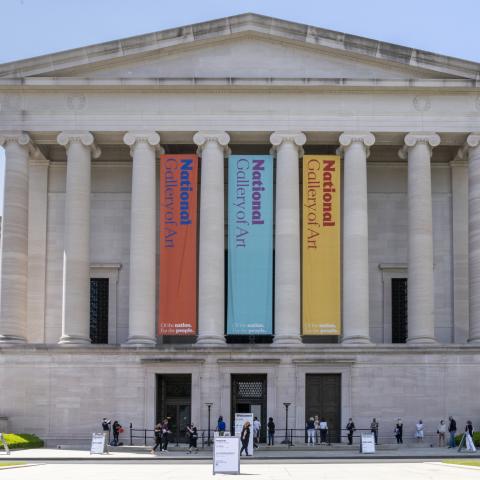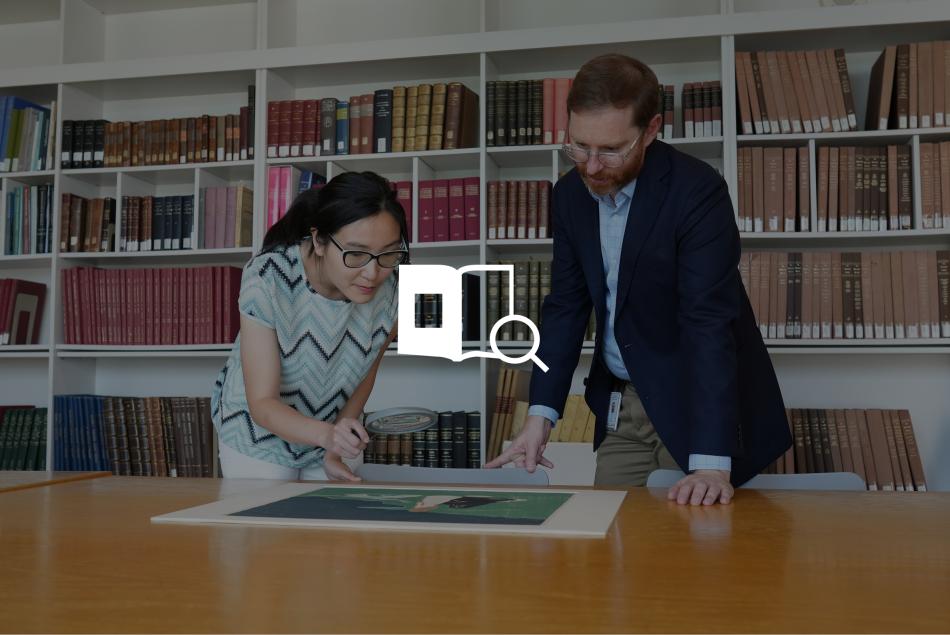Doge Alvise Mocenigo and Family before the Madonna and Child
c. 1575
Painter, Venetian, 1518 or 1519 - 1594

Alvise Mocenigo was the fourth member of his family to become doge (elected chief of state) of Venice. He sits on the lower left wearing symbols of his office: an ermine cloak and Venetian ducal hat. It was custom for large paintings like this to show officials and their families worshipping or being presented to the Virgin Mary and the Christ Child. Such paintings were meant to celebrate and enhance family power.
Opposite Mocenigo is his wife Loredana. The older man standing at left is the doge’s brother Giovanni. And the two young men at right are Giovanni’s sons Tommaso and Alvisetto. Traditionally, the angel musicians also represented family members, but we have no evidence of that in this case.

West Building Main Floor, Gallery 24
Artwork overview
-
Medium
oil on canvas
-
Credit Line
-
Dimensions
overall: 216 × 416 cm (85 1/16 × 163 3/4 in.)
framed: 252.8 × 452.2 × 12.7 cm (99 1/2 × 178 × 5 in.)
framed weight: 154.223 kg (340 lb.); unframed weight: 143 lb -
Accession
1961.9.44
More About this Artwork
Artwork history & notes
Provenance
Probably originally at the Palazzo Mocenigo at San Samuele, Venice. Alvise I Mocenigo, called "Toma" [b. 1608], Palazzo Mocenigo at San Samuele, Venice, by 1648.[1] Possibly acquired in Italy in the early 19th century by a member of the Gouvello family, France; by inheritance to Pierre-Armand-Jean-Vincent-Hippolyte, marquis de Gouvello de Keriaval [1782-1870], Château de Kerlévénan, Sarzeau (department Morbihan in Britanny), France; by inheritance in his family; sold 1952 through (Landry and de Somylo) to (M. Knoedler and Co., London, New York and Paris) on joint account with (Pinakos, Inc. [Rudolf Heinemann], New York); sold 1953 to the Samuel H. Kress Foundation, New York;[2] gift 1961 to NGA.
[1] ] Carlo Ridolfi, Le maraviglie dell’arte, overo Le vite de gl'illustri pittori veneti, e dello stato, 2 vols., Venice, 1648: 2:44; Carlo Ridolfi, Le maraviglie dell’arte, overo Le vite de gl'illustri pittori veneti, e dello stato, edited by Detlev von Hadeln, 2 vols., Berlin, 1914-1924: 2:53. Tracy Cooper's identification of the owner Ridolfi cites as "Toma Mocenigo" is explained in her article "The Trials of David: Triumph and Crisis in the Imagery of Doge Alvise I Mocenigo," Records of Activities and Research Reports 18 (June 1997-1998), Center for Advanced Study in the Visual Arts, National Gallery of Art, Washington: 66-67.
[2] For the provenance from the marquis to the sale to the Kress Foundation, see the invoice from M. Knoedler & Co. dated 2 June 1953, and M. Knoedler & Co. Records, accession number 2012.M.54, Research Library, Getty Research Institute, Los Angeles: Stock book no. 10, p. 83, no. A4949, and Sales book, p. 17. The invoice and copies from the Knoedler Records are in NGA curatorial files. See also The Kress Collection Digital Archive, https://kress.nga.gov/Detail/objects/669.
Associated Names
Exhibition History
1994
Jacopo Tintoretto--I Ritratti [Jacopo Tintoretto: Portraits], Gallerie dell'Accademia, Venice; Kunsthistorisches Museum, Vienna, 1994, no. 35, repro.
2018
Tintoretto: Artist of Renaissance Venice, Gallerie dell'Accademia and Palazzo Ducale, Venice; National Gallery of Art, Washington, 2018-2019, fig. 144.
Bibliography
1648
Ridolfi, Carlo. Le maraviglie dell’arte, overo Le vite de gl'illustri pittori veneti, e dello Stato. 2 vols. Venice, 1648: 2:44.
1914
Ridolfi, Carlo. Le maraviglie dell’arte, overo Le vite de gl'illustri pittori veneti, e dello Stato (Venice, 1648). Edited by Detlev von Hadeln. 2 vols. Berlin, 1914-1924: 2(1924):53.
1915
Osmaston, Francis P. B. The Art and Genius of Tintoret. 2 vols. London, 1915: 169.
1926
Pittaluga, Mary. “Opere del Tintoretto smarrite o di malsicuro identificazione.” L’Arte 29 (1926): 89 (as lost).
1954
Pallucchini, Rodolfo. “Un capolavoro del Tintoretto: la Madonna del Doge Alvise Mocenigo.” Arte Veneta 8 (1954): 222-235, figs. 235, 237, 240, 242, 244, 245, 248, 249.
1956
Paintings and Sculpture from the Kress Collection Acquired by the Samuel H. Kress Foundation 1951-56. Introduction by John Walker, text by William E. Suida and Fern Rusk Shapley. National Gallery of Art. Washington, 1956: 176, no. 70, repro.
Walker, John. "The Nation's Newest Old Masters." The National Geographic Magazine 110, no. 5 (November 1956): 622, color repro. 632.
1957
Berenson, Bernard. Italian Pictures of the Renaissance. Venetian School. 2 vols. London, 1957: 1:176.
1959
Paintings and Sculpture from the Samuel H. Kress Collection. National Gallery of Art, Washington, 1959: 206, repro.
1961
Walker, John, Guy Emerson, and Charles Seymour. Art Treasures for America: An Anthology of Paintings & Sculpture in the Samuel H. Kress Collection. London, 1961: 130, repro. pl. 120, 121.
1963
Walker, John. National Gallery of Art, Washington, D.C. New York, 1963 (reprinted 1964 in French, German, and Spanish): 308, repro.
1964
Savini Branca, Simona. Il collezionismo veneziano del Seicento. Padua, 1964: 243.
1965
Summary Catalogue of European Paintings and Sculpture. National Gallery of Art, Washington, 1965: 128.
1968
National Gallery of Art. European Paintings and Sculpture, Illustrations. Washington, 1968: 114, repro.
1969
Rossi, Paola. “Una recente pubblicazione sul Tintoretto e il problema della sua ritrattistica.” Arte Veneta 23 (1969): 269.
1970
De Vecchi, Pierluigi. L’opera completa del Tintoretto. Milan, 1970: 114, no. 204.
1972
Fredericksen, Burton B., and Federico Zeri. Census of Pre-Nineteenth Century Italian Paintings in North American Public Collections. Cambridge, Mass., 1972: 201.
Pallucchini, Rodolfo. “Due nuove opere giovanili di Jacopo Tintoretto.” Arte Veneta 26 (1972): 54.
1973
Zeri, Federico, and Elizabeth Gardner. Italian Paitnings. A Catalogue of the Metropolitan Museum of Art: Venetian School. New York, 1973: 70-71.
Shapley, Fern Rusk. Paintings from the Samuel H. Kress Collection: Italian Schools, XVI-XVIII Century. London, 1973: 56-57, fig. 99-101.
1974
Rossi, Paola. Jacopo Tintoretto: I ritratti. Venice, 1974: 13, 67-68, fig. 161.
1975
European Paintings: An Illustrated Summary Catalogue. National Gallery of Art, Washington, 1975: 342, repro.
1979
Shapley, Fern Rusk. Catalogue of the Italian Paintings. 2 vols. National Gallery of Art, Washington, 1979: 1:473-474; 2:pl. 338, 338A.
Watson, Ross. The National Gallery of Art, Washington. New York, 1979: 41, pl. 25.
1982
Pallucchini, Rodolfo, and Paola Rossi. Tintoretto: le opere sacre e profane. 2 vols. Venice, 1982: 1:30, 77, 79, 80, 101, 104, 195-197, 199, 222, 236-237; 2:pls. 421-423.
1983
Wolters, Wolfgang. Der Bilderschmuck des Dogenpalastes: Untersuchungen zur Selbstdarstellung der Republik Venedig im 16. Jahrhundert. Wiesbaden, 1983: 124, fig. 103.
1984
Walker, John. National Gallery of Art, Washington. Rev. ed. New York, 1984: 230, no. 288, color repro.
1985
European Paintings: An Illustrated Catalogue. National Gallery of Art, Washington, 1985: 393, repro.
1987
Wolters, Wolfgang. Storia e politica nei dipinti di Palazzo Ducale: aspetti dell’autocelebrazione della Repubblica di Venezia nel Cinquecento. Translated by Benedetta Heinemann Campana. Venice, 1987: 123, fig. 102.
1991
Stefaniak, Regina. “Raphael’s Santa Cecilia: A Fine and Private Vision of Virginity.” Art History 14 (1991): 371, n. 48.
1993
Weber, Annette. Venezianische Dogenporträts des 16. Jahrhunderts. Sigmaringen, 1993: fig. 53.
1995
Rearick, W. R. “Reflections on Tintoretto as a Portraitist.” Artibus et Historiae 16, no. 31 (1995): 62.
Polleross, Friedrich. “Della Bellezza & della Misura & della Convenevolezza: Bemerkungen zur venezianischen Porträtmalerei anläßlich der Tintoretto-Ausstellungen in Venedig und Wien.” Pantheon 53 (1995): 40, fig. 12 (detail).
1998
Cooper, Tracy. "The Trials of David: Triumph and Crisis in the Imagery of Doge Alvise I Mocenigo." Records of Activities and Research Reports 18 (June 1997-1998), Center for Advanced Study in the Visual Arts, National Gallery of Art, Washington: 64-68.
1999
Goffen, Rona. “Crossing the Alps: Portraiture in Renaissance Venice.” In Renaissance Venice and the North: Crosscurrents in the Time of Bellini, Dürer, and Titian. Edited by Bernard Aikema and Beverly Louise Brown. Exh. cat. Palazzo Grassi, Venice. Milan, 1999: 120.
2005
Cooper, Tracy E. Palladio’s Venice: Architecture and Society in a Renaissance Republic. New Haven, 2005: 193-195, 200, 320 n. 118, 332 n. 41, 333 nn. 42 and 43, fig. 197.
2007
Cooper, Tracy E. “Patricians and Citizens.” In Venice and the Veneto. Edited by Peter Humfrey. New York, 2007: 155, fig. 98.
Falomir, Miguel, ed. Tintoretto. Exh. cat. Museo Nacional del Prado, Madrid, 2007: 111, 328 fig. 170, 329 (the figure caption incorrectly gives the NGA accession number as 1491.9.44).
2008
Gibellini, Cecilia. L'immagine di Lepanto: la celebrazione della vittoria nella letteratura e nell'arte veneziana. Venice, 2008: 53, 167-169, fig. 37.
2009
Echols, Robert, and Frederick Ilchman. “Toward a New Tintoretto Catalogue, with a Checklist of Revised Attributions and a New Chronology.” In Jacopo Tintoretto: Actas del congreso internacional/Proceedings of the International Symposium, Museo Nacional del Prado, Madrid, February 26-27, 2007. Madrid, 2009: 126, no. 158.
2014
Paul, Benjamin. “Convertire in se medesimo questo flagello: autocritica del Doge Alvise Mocenigo nel bozzetto di Tintoretto per il dipinto votivo a Palazzo Ducale.” In Celebrazione e autocritica: la Serenissima e la ricerca dell’identità veneziana nel tardo Cinquecento. Edited by Paul Benjamin. Rome, 2014: 134 n. 25.
Wikidata ID
Q20176763




